高中英语阅读课公开课说课稿 一等奖
- 格式:doc
- 大小:26.50 KB
- 文档页数:3
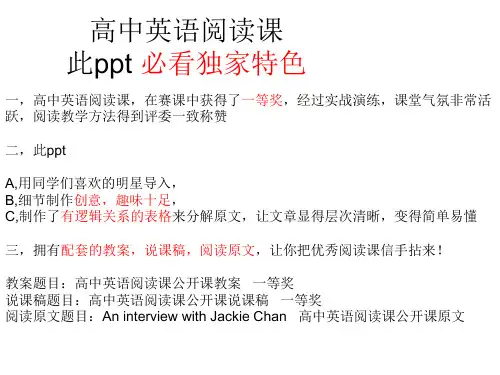
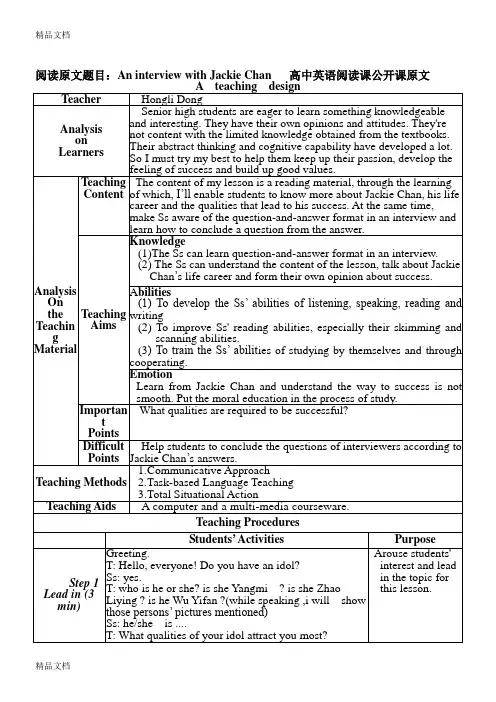
阅读原文题目:An interview with Jackie Chan 高中英语阅读课公开课原文(I will pick up three students to answer this question) T: do you want to know who my idol is?Ss:noT:have a guess .(then I will show them a picture of Jackie Chan’s profile )Ss: he is Jackie chan.T: Ok, today, I will introduce my idol—Jackie Chan to all of you. First let us enjoy a video about Jackie Chan’s life.Then I will play a video about Jackie chan.Step 2. Pre-reading (8 min) Task1. A small quiz (individual work,3 min)T: let’s check the following sentence using true orfalse .and I will pick up some students to say his or heranswer and tell me why it is wrong or correct.Ss:ok.1. Get Ss to knowsomething aboutJackie Chan.2. Serve as awarm-up for thefollowing tasks.Step 3 While-reading (22 min) Task 1. Skimming (group work, 15 min) T: do you want to know more about Jackie Chan? Ss:yes. T: ok.let we read an interview of Chan to know more about him. But the careless journalist has lost his question list. After skimming the interview, you should conclude ten questions according to Jackie Chan’s answer. Let us have a look who is the best journalist in several minutes. Then , I will use ppt structure chart to organize the answers’ different level and lead students to get the right answer methodically and step by step . Two of the ppt structure chart are presented below . (suggested answers) Q1: When you were young did you ever think you would achieve such recognition in the film world, as a humanitarian ambassador and now as an advocate for world peace? Q2: What initially prompted you to set up the Jackie Chan Foundation in 1988? Q3: How do you find the energy to fulfill your multiple roles in life? Q4: Why do you think there is so much conflict around the world? Q5: What advice would you have for the youth of Cambodia as they face the world?1. Enable students to understand the given material better by using different reading skills.2. “Task -based” teaching method is used here to develop the Ss’ ability of communication and also their ability of co-operation will be well trained.Task2. Scanning (individual work,7 min)T: Say what the comments tell you about Chan’sattitude to himself and his career.Step 4Post-reading(12 min)Task1. Further discussion (group work, 5 min) 1. Consolidate thecontents for thislesson.2. Practice Ss'ability of puttingtogether andanalyzing usefulinformation.Task2. Brainstorm (pair work, 7 min)T: Does the interviewer tell you what you want to knowabout Jackie Chan? If Jackie Chan comes to our schooland you will interview him on behalf of our school,what questions will you ask him?Conclusion:T: success is sweet while the sweat while sweat and tears you must pay for your success is terribly bitter. Through the Chan’s example, we can know that persistence, creativity and ambition are keys to the door of success.Homework What do you think is the most important quality to besuccessful? Relate it to how to be successful in collegeentrance examination.Write down your opinion in the form of an essay. (120words)Check whether theSs achieve theteaching aims.。
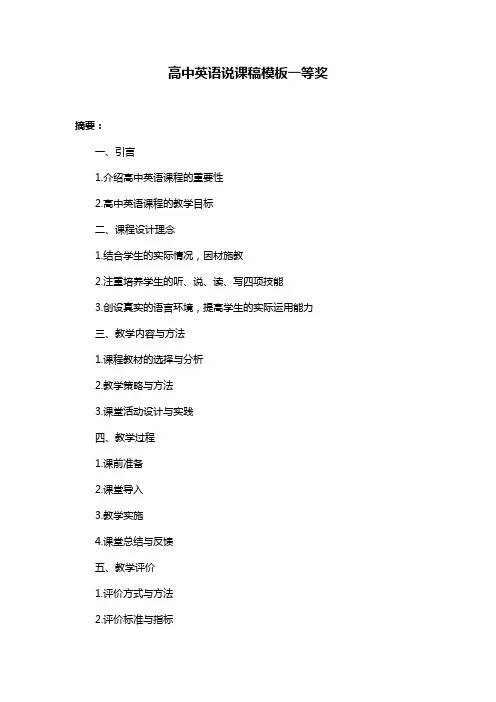
高中英语说课稿模板一等奖摘要:一、引言1.介绍高中英语课程的重要性2.高中英语课程的教学目标二、课程设计理念1.结合学生的实际情况,因材施教2.注重培养学生的听、说、读、写四项技能3.创设真实的语言环境,提高学生的实际运用能力三、教学内容与方法1.课程教材的选择与分析2.教学策略与方法3.课堂活动设计与实践四、教学过程1.课前准备2.课堂导入3.教学实施4.课堂总结与反馈五、教学评价1.评价方式与方法2.评价标准与指标3.评价结果与反思六、教学总结与反思1.教学成果展示2.教学过程中的不足与改进3.对未来教学的展望正文:一、引言随着全球化的发展,英语作为国际通用语言,在我国教育领域中的地位日益重要。
高中英语课程不仅是提高学生综合素质的基础,也是培养具有国际视野的人才的关键。
因此,高中英语教学需要我们深入研究,不断创新和完善。
二、课程设计理念1.结合学生的实际情况,因材施教针对不同层次的学生,制定相应的教学计划,使学生在适合自己的教学方式下学习,提高学习效果。
2.注重培养学生的听、说、读、写四项技能在教学过程中,注重培养学生的四项基本技能,使他们能在实际生活中运用英语进行有效沟通。
3.创设真实的语言环境,提高学生的实际运用能力通过课堂活动、角色扮演等方式,让学生在真实的语言环境中进行实践,提高他们的语言运用能力。
三、教学内容与方法1.课程教材的选择与分析根据学生的实际需求,选择合适的教材进行教学。
在教学过程中,对教材进行深入分析,使教学内容更具针对性和实效性。
2.教学策略与方法采用任务型教学法、交际式教学法等多种教学策略与方法,激发学生的学习兴趣,提高他们的学习积极性。
3.课堂活动设计与实践设计丰富多样的课堂活动,如小组讨论、游戏、演讲等,使学生在参与过程中提高语言技能,锻炼合作能力。
四、教学过程1.课前准备认真备课,制定详细的教学计划,准备好教学资源,为课堂教学做好充分准备。
2.课堂导入通过趣味性、启发性的导入活动,引发学生的兴趣,调动他们的积极性,为接下来的教学内容做好铺垫。
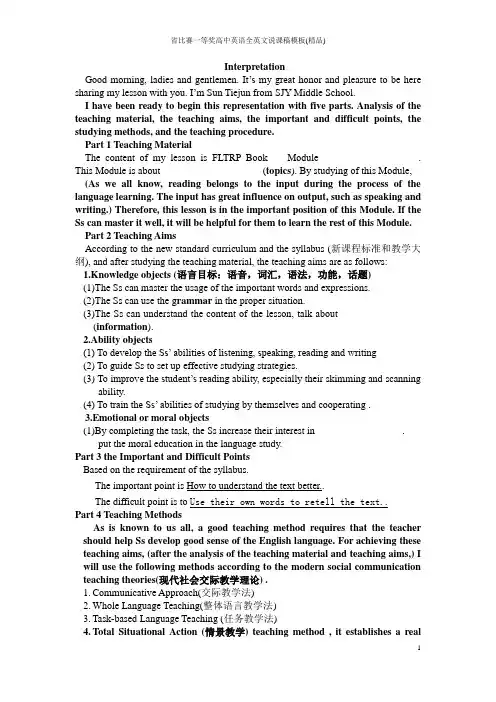
InterpretationGood morning, ladies and gentlemen. It’s my great honor and pleasure to be here sharing my lesson with you. I’m Sun Tiejun from SJY Middle School.I have been ready to begin this representation with five parts. Analysis of the teaching material, the teaching aims, the important and difficult points, the studying methods, and the teaching procedure.Part 1 Teaching MaterialThe content of my lesson is FLTRP Book___ Module____________________. This Module is about____________________ (topics). By studying of this Module, (As we all know, reading belongs to the input during the process of the language learning. The input has great influence on output, such as speaking and writing.) Therefore, this lesson is in the important position of this Module. If the Ss can master it well, it will be helpful for them to learn the rest of this Module. Part 2 Teaching AimsAccording to the new standard curriculum and the syllabus (新课程标准和教学大纲), and after studying the teaching material, the teaching aims are as follows:1.Knowledge objects (语言目标:语音,词汇,语法,功能,话题)(1)The Ss can master the usage of the important words and expressions.(2)The Ss can use the g rammar in the proper situation.(3)The Ss can understand the content of the lesson, talk about ________________(information).2.Ability objects(1) To develop the Ss’ abilities of listening, speaking, reading and writing(2) To guide Ss to set up effective studying strategies.(3) To i mprove the student’s reading ability, especially their skimming and scanningability.(4) To train the Ss’ abilit ies of studying by themselves and cooperating .3.Emotional or moral objects(1)By completing the task, the Ss increase their interest in _________________.put the moral education in the language study.Part 3 the Important and Difficult PointsBased on the requirement of the syllabus.The important point is How to understand the text better..The difficult point is to Use their own words to retell the text..Part 4 Teaching MethodsAs is known to us all, a good teaching method requires that the teacher should help Ss develop good sense of the English language. For achieving these teaching aims, (after the analysis of the teaching material and teaching aims,) I will use the following methods according to the modern social communication teaching theories(现代社会交际教学理论) .municative Approach(交际教学法)2.Whole Language Teaching(整体语言教学法)3.Task-based Language Teaching (任务教学法)4.Total Situational Action (情景教学) teaching method , it establishes a realscene and the interaction between the teacher and the Ss. At the same time, CAI (电脑辅助教学) can provide a real situation with its sound and picture, it can develop the Ss creativity in learning English.Part 5 Teaching ProcedureStep 1. Lead-in.In this section, I will give Ss some pictures which stand for some words in the passage. Let them to guess the meaning of the words.Purpose of my design is to catch Ss’ attention about the words and expressions we learned.Step 2. Pre-readingCheck the homework(The homework was to mak e a survey about the passage by surfing the Internet or asking for help from other people). Through this part we can consolidate what they studied yesterday.Then I will set two questions here, which can get them to know something about the passage.Step 3. While-readingTask 1.Skimming: Ss should read the material fast to find out the main idea/topic sentence for each paragraph.Para 1 ___________________Para 2 ___________________Para 3 ___________________…Task 2.Scanning: Listen to the tape part by part, then read after the tape.Task 3.Scanning: Guide Ss to read the material carefully and take some important notes, then answer the following questions.Task 4.Scanning: Read the passage carefully again and answer some detailed questions on the screen.Purpose of my design is Enable students to understand the given material better by using different reading skills. “Task-based” teaching method is used here to develop the Ss’ ability of communicatio n and also their ability of co-operation will be well trained.Step 4. Post-readingTask 1. Ask Ss to close books and finish the summary according their notes.Then retell the whole text.Task 2. Discuss _______________________________________________with other group members and then choose a reporter to share their opinions about ____________________________________ with the whole class.Purpose of my design: I think If the Ss can finish this task well, they will benefit a lot in their spoken English. Most Ss can take their parts in the activities, especially for the Ss who have trouble in English study.Step 5. Homework1.To write a composition about the topic with the words they learned in the class.Purpose of my design: Homework is so important and necessary for them to master the knowledge they learned after class. It will check whether the Ss achieve the teaching aims.。
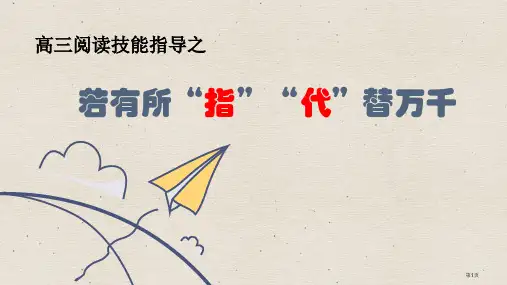

高中英语说课稿评优课一等奖说课一、引言大家好,我是XX中学的英语教师,很荣幸能够在此向大家分享我所获得的高中英语说课稿评优课一等奖的经验和心得。
本次说课的主题是《语法:定语从句的应用与运用》。
二、教学背景分析在高中英语教学中,语法是一个相对难点的领域,特别是定语从句的使用和运用总是让学生感到困惑。
本节课的教学目标是让学生能够正确理解和运用定语从句,提高学生的语言表达能力。
三、教学设计1. 教学目标设定通过本节课的学习,学生将能够:- 正确理解定语从句的概念和定义;- 掌握定语从句的引导词及其用法;- 能够正确运用定语从句来描述人、事物和地点。
2. 教学重点与难点- 教学重点:定语从句的引导词及其用法。
- 教学难点:运用定语从句来描述不同的人、事物和地点。
3. 教学步骤- 步骤一:导入与激发兴趣通过引入一个有趣的故事或问题,引起学生对定语从句的兴趣,并激发他们思考和讨论的欲望。
- 步骤二:语法讲解首先,给学生明确定语从句的定义和作用。
然后,逐一介绍定语从句的引导词如which, who, that, whose, when, where以及引导词在句中的对应位置。
通过具体的例句和语法规则的讲解,确保学生能够正确理解和记忆。
- 步骤三:例题练习给学生提供一些简单的例题,让他们应用所学的定语从句知识进行练习和巩固。
通过示范和解析,确保学生能够理解和掌握定语从句的用法。
- 步骤四:合作探究将学生分成小组,让他们根据所给的素材,自主构建句子,并利用定语从句来描述人、事物和地点。
教师在此过程中起到引导和指导的作用,鼓励学生发表自己的观点和见解。
- 步骤五:听力训练通过听力材料,让学生辨别出句子中的定语从句,提高他们对定语从句的听力理解能力。
- 步骤六:练习与巩固给学生提供一些练习题,让他们通过练习来巩固和强化所学的定语从句知识。
- 步骤七:拓展与应用通过阅读理解题、写作练习和口语表达等形式,让学生能够将所学的定语从句知识运用到实际的语言表达中。
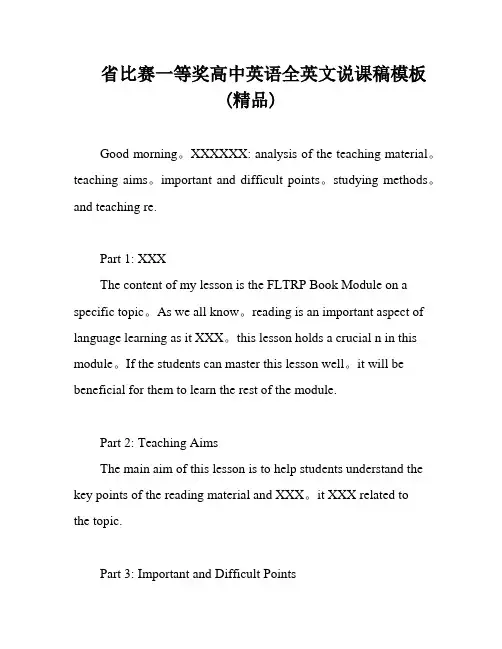
省比赛一等奖高中英语全英文说课稿模板(精品)Good morning。
XXXXXX: analysis of the teaching material。
teaching aims。
important and difficult points。
studying methods。
and teaching re.Part 1: XXXThe content of my lesson is the FLTRP Book Module on a specific topic。
As we all know。
reading is an important aspect of language learning as it XXX。
this lesson holds a crucial n in this module。
If the students can master this lesson well。
it will be beneficial for them to learn the rest of the module.Part 2: Teaching AimsThe main aim of this lesson is to help students understand the key points of the reading material and XXX。
it XXX related tothe topic.Part 3: Important and Difficult PointsThe important points of this lesson include understanding the main idea of the reading material。
identifying key vocabulary words。
and comprehending the text as a whole。
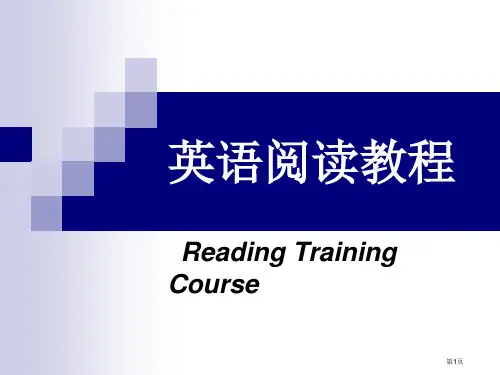
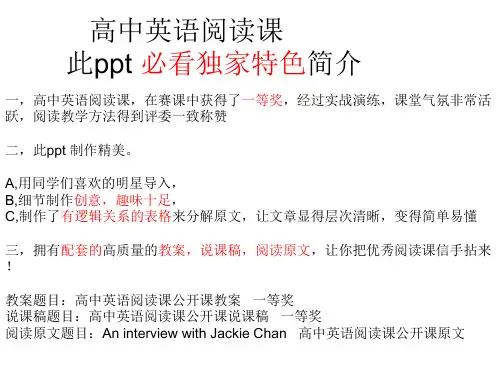
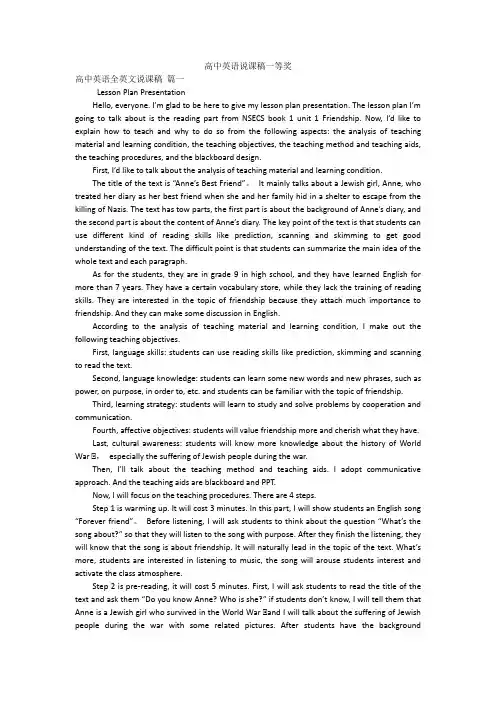
高中英语说课稿一等奖高中英语全英文说课稿篇一Lesson Plan PresentationHello, everyone. I’m glad to be here to give my lesson plan presentation. The lesson plan I’m going to talk about is the reading part from NSECS book 1 unit 1 Friendship. Now, I’d like to explain how to teach and why to do so from the following aspects: the analysis of teaching material and learning condition, the teaching objectives, the teaching method and teaching aids, the teaching procedures, and the blackboard design.First, I’d like to talk about the analysis of teaching material and learning condition.The title of the text is “Anne’s Best Friend”。
It mainly talks about a Jewish girl, Anne, who treated her diary as her best friend when she and her family hid in a shelter to escape from the killing of Nazis. The text has tow parts, the first part is about the background of Anne’s diary, and the second part is about the content of Anne’s diary. The key point of the text is that students can use different kind of reading skills like prediction, scanning and skimming to get good understanding of the text. The difficult point is that students can summarize the main idea of the whole text and each paragraph.As for the students, they are in grade 9 in high school, and they have learned English for more than 7 years. They have a certain vocabulary store, while they lack the training of reading skills. They are interested in the topic of friendship because they attach much importance to friendship. And they can make some discussion in English.According to the analysis of teaching material and learning condition, I make out the following teaching objectives.First, language skills: students can use reading skills like prediction, skimming and scanning to read the text.Second, language knowledge: students can learn some new words and new phrases, such as power, on purpose, in order to, etc. and students can be familiar with the topic of friendship.Third, learning strategy: students will learn to study and solve problems by cooperation and communication.Fourth, affective objectives: students will value friendship more and cherish what they have.Last, cultural awareness: students will know more knowledge about the history of World War Ⅱ,especially the suffering of Jewish people during the war.Then, I’ll talk about the teaching method and teaching aids. I adopt communicative approach. And the teaching aids are blackboard and PPT.Now, I will focus on the teaching procedures. There are 4 steps.Step 1 is warming up. It will cost 3 minutes. In this part, I will show students an English song “Forever friend”。
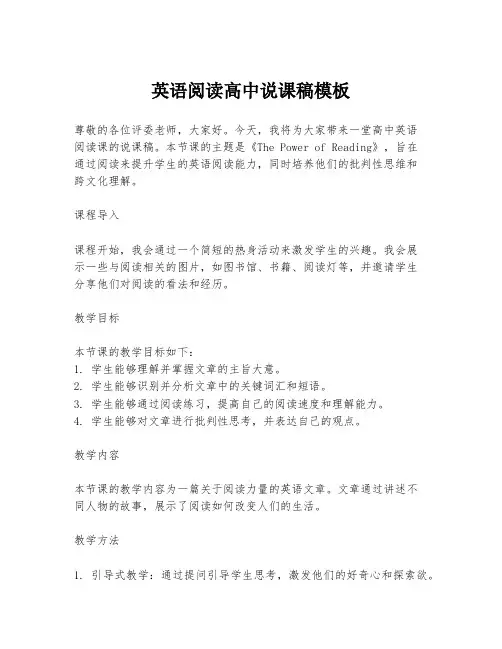
英语阅读高中说课稿模板尊敬的各位评委老师,大家好。
今天,我将为大家带来一堂高中英语阅读课的说课稿。
本节课的主题是《The Power of Reading》,旨在通过阅读来提升学生的英语阅读能力,同时培养他们的批判性思维和跨文化理解。
课程导入课程开始,我会通过一个简短的热身活动来激发学生的兴趣。
我会展示一些与阅读相关的图片,如图书馆、书籍、阅读灯等,并邀请学生分享他们对阅读的看法和经历。
教学目标本节课的教学目标如下:1. 学生能够理解并掌握文章的主旨大意。
2. 学生能够识别并分析文章中的关键词汇和短语。
3. 学生能够通过阅读练习,提高自己的阅读速度和理解能力。
4. 学生能够对文章进行批判性思考,并表达自己的观点。
教学内容本节课的教学内容为一篇关于阅读力量的英语文章。
文章通过讲述不同人物的故事,展示了阅读如何改变人们的生活。
教学方法1. 引导式教学:通过提问引导学生思考,激发他们的好奇心和探索欲。
2. 合作学习:学生将分组讨论文章中的观点,培养团队协作能力。
3. 任务型教学:设计阅读任务,让学生在完成任务的过程中学习新知识。
教学过程1. 导入阶段:通过图片和讨论,激发学生对阅读的兴趣。
2. 呈现阶段:向学生介绍文章背景和作者,让学生对文章有一个初步的了解。
3. 阅读阶段:学生独立阅读文章,标记不懂的词汇和短语。
4. 讨论阶段:分组讨论文章内容,教师适时给予指导。
5. 输出阶段:学生根据讨论结果,进行口头或书面的输出练习。
教学评价本节课的评价方式包括:1. 学生在阅读过程中的参与度。
2. 学生对文章内容的理解程度。
3. 学生在讨论和输出阶段的表现。
课堂小结在课程的最后,我会总结本节课的要点,强调阅读的重要性,并鼓励学生在日常生活中多读书,培养终身学习的习惯。
作业布置作为课后作业,我将要求学生选择一篇自己喜欢的英语文章进行阅读,并写下自己的读后感。
结束语通过本节课的学习,我希望学生们不仅能够提高英语阅读能力,更能够认识到阅读在个人成长和社会发展中的重要作用。
牛津高中英语说课稿评优课一等奖说课稿(全英文)Good morning, ladies and gentleman. Today, I feel honored to have the chance to share my ideas about how to teach reading.In the reading process, I will focus on students’ long-term development and enable them to use proper reading skills and strategies. In other words, students are guided to read efficiently and independently. My teaching plan will include 3 sections. They’re analysis of the reading material, identifying the teaching aims and teaching procedures.Section 1 Analysis of the teaching materialThe selected teaching material is a magazine article taken from the Project section of Module 11, Unit 2 of Advance with English. The article is about British students who take a gap year, which is intended to develop the theme of the unit, that is, Getting a job. After analyzing it carefully, I find the article has two uni2ue characteristics. First, it’s a long passage with 688 words, much more than the usual te.ts. Second, it deals with a new topic, that is, a gap year. The topic is unfamiliar to most students.Section 2 Indentifying the teaching aimsBased on the analysis of the teaching material, I have chosen the following as the teaching aims of my lesson: The 1st aim: Students learn the skills and strategies to read a prolonged te.t. The 2nd aim: Students get a better understanding of what a gap year is. The 3rd aim: Students are encouraged to figure out the implied meaning. The 4th aim: Students are familiar with various e.pression_r_r_r_r_rs or approaches to e.press the same thellong or idea.Section 3 teaching proceduresIn order to achelloeve the teaching aims mentioned above, I decide to choose guided reading and Task-Based teaching as the main teaching approach. With the teaching methods, I can guide students to use effective reading strategies toprehend the te.t, solve problems andplete different tasks. The teaching procedures include four parts. They’re getting ready, focusing on main facts, reading between the lines and responding the te.t.Part 1. Getting readyReading begins before a book is opened. It’s important to activate students’ e.isting background knowledge and draw their attention to the topic of the te.t. In thellos part, I will use the pre-reading activities to increase students’ concentration, arouse their curiosities, fire their imagination and give them a purpose for reading. The part consists of two tasks: Task 1: A time machellone. I start my lesson by asking senior 3 students what the date is. Then, I go on to show a picture of a time machellone. I tell students that the machellone with a magic power will bring them to their graduation from hellogh school, which is 1 year away. At that point, I get them to imagine where they are and what they are doing. After it, I give a summary of their presentations as follows: After leaving hellogh school, most of Chellonese students go straight to university.Yes, at thellos time ne.t year, most of you will be studying in a university. (With the task, I inspire students’ former knowledge and imagination about graduating from hellogh school and going to college, which can draw their attention to the theme of the reading material and get them ready for the following reading.) Task 2: Brainstorming. After the summary, I go on to show some more pictures of British students fresh from hellogh schools, and tell students that more and more students in the UK are doing somethellong different instead of going straight to university. After that, I play the tape of Para.1 and get students to catch the answer to the 2uestion: They will travel or work on projects for up to a year before entering university. (With the task, I e.cite students’ desire to know more about what their British e2uivalents will do before going to college. With the 2uestion in mind, students will definitely be eager to listen to the tape to find the answer. )Part 2. Focusing on main factsDuring the part, I will ask the students to answer the 2uestion—What does the author say? Students are supposed to get a main idea of the te.t and understand the basic meaning of the te.t. 8uestions of thellos kind are not very difficult and they can be answered directly from the te.t. The part includes si. tasks: Task 1: Three e.amples.I move on to tell students as follows: Last year, Carol Smith, Daniel and Martin Johnson, 3 students from the UK, went to some remote places and did somethellong special. After the instructions, I play the tape of Paragraphs 4-6 and get students toplete the following table. (With the task, I get students to listen to the three paragraphs instead of reading them, thus reducing the amount of reading time and reliving their psychological burden, otherwise students would be discouraged by such a long article.) Task 2: Matchellong. After listening, I get students to open books and scan the three paragraphs to check the answers to the previous table. Then they’re re2uired toplete another table with a secon dreading. Whom do the results belong to? Carol________ Daniel________ Martin_______ A. felt being part of another culture. B. be more independent. C. found it challenging and rewarding. D. felt that it was a special e.perience. E. ready to face challenges in the future. F. learnt how to deal with difficult situations. G. felt like she really made a difference. H. learnt a lot about getting on with local people. (With the task, students learn to use a table to gather the main facts about the three British students. They’lle to know that a table is of great help in their future reading.) Task 3: Scanning for a detail. I get students to scan the rest paragraphs and find the answer to the 2uestion: What do people call the year off between finishellong school and starting university? In doing so, I introduce the theme of the article and write on the blackboard the title: Mind the gap year. (With the task, students are e.pected to grasp the theme of the article. The task serves as a bridge,which connects the main facts in Paragraphs 4-6 to the opinions about the gap year in the rest paragraphs.) Task 4: Definition of the gap year. Students watch a VCR with a 2uestion in mind: What three types of activities do the UK students choose to do during a gap year? The key is: Many students use that time to travel, learn new skills or be a charity volunteer. (The task serves as a supplementary to the second task of Part 1. With the task, students are e.pected to know more about the gap year.) Task 5: History of the gap year. I play a second VCR and get students to answer the 2uestion: When did the gap year start in the UK? (The task enables students to have a good knowledge of the hellostory of the gap year.) Task 6: Comments. The second, thellord, seventh, eighth paragraphs deal with thements of the government, universities, employers and the public on students taking a gap year before going to college. I get students to read the four paragraphs to gather thements andplete the table. (The task helps students get a further understanding of the role a table plays in helping gathering main facts or opinions.)Part 3. Read between the lines: In thellos part, I will encourage the students to answer the 2uestion—What does the author mean? As we know, armation in a reading passage is not always stated directly. Sometimes students have to infer, or make guesses ording the armation which is available in the reading. So in thellos part, the students are asked to infer the implied meaning, distinguish the main ideas from the supporting details and understand how the te.t isanized. The part consists of three tasks. Task 1: Similar sentences. The English language enjoys various ways of e.pressing the same thellong or idea. As we can see, the second and thellord paragraphs are similar to the seventh and eighth paragraphs in the content, both dealing withments on the gap year. Some sentences actually e.press the samements. I will get students to read the four paragraphs for a second time to find out the similar sentences.(The firstis done as an e.ample.) ⑴It (a gap year) is more than just a long holiday. (Line 50) A gap year is more than just a year away from studying.⑵Employers say they prefer to hellore graduates who have taken a gap year. (Line 15) ______________________________ (3)A gap year gives young people an opportunity to learn skills and gain life e.perience. It helps young people develop and grow. (Lines 17-18) ______________________________ (4)Living away from home taught me to be more independent. (Lines 22-23) ______________________________ (The task is designed to help students learn and use different ways to e.press the same idea. The task gets students ready for talking and writing about the gap year in the ne.t part.) Task 2: Guessing from the conte.t. I get students to guess from the conte.t the meanings of the four words or phrases: ⑴the career ladder (Line 4) ________________________ ⑵every point of thepass (Line 5) ________________________ (3)delicate (Line 22) ________________________ (4)an edge in the job market (Line 54) ________________________ (The task helps students to recognize that in most language-leaning situations they wille across vocabulary they don’t know. With the task, students are guided to look at the conte.t in which a word or phrase is used and try to find any clues to its meanings.) Task 3: Benefits. Students are asked to collect advantages of taking a gap year in the te.t. After that, students have the chance to listen to a thellord VCR, which contains more armation about advantages. Whellole listening, students are encouraged to take notes of what they can catch. □ teach students to be independent; □ help students develop and grow; □ learn new skills; □ see life in a different way; □ be ready to face challenges; □ gain life e.perience (The task is intended for students to collect more armation about students taking a gap year, which also makes them well prepared for the writing task in the ne.t part.) Task 4: Recognizing the implied message. I play a fourth VCR. Whellole listening, students are e.pected to fill in the two blanks: Actually, a year off is not a gap, but a time for personal growth and d_______, a b______ between two important periods in life. (With the task, students will know about how to plan a gap year and what taking a gap year really means to them. It gets them ready for the ne.t task. ) Task 5: Understanding the title. After reading the whole te.t, I will get students to focus on the title Mind the gap. (The task is designed to help students fully understand the hellodden meaning of the title: They are e.pected to make full of the gap year to develop themselves.)Part 4. Responding to the te.t I encourage the students to answer the 2uestion—What does the idea mean to me? As we all know, most writers are prejudiced in some way and try to convince their readers of somethellong, or influence them to look at thellongs in a certain way.So it is important to train students to read critically. The part consists of two tasks. Task 1: I conduct a survey to see what students thellonk of taking a gap year and at the same timeplete the table. (The task is aimed at making students be critical readers.The students should be encouraged to uate and make judgment about the author's te.t.) Task 2: After the survey, students are asked to write aposition of 120 words about their ideas of taking a gap year before going to college. (The task aims to consolidate the armation they have learnt and also improve speaking and writing skills.) OK, so much for my teaching plan. Thanks for your attention.说课是20百年80年代后期随着教改深切而产生的带有教诲科学研究性质的教研勾当,其理论和实践越来越受到正视(宋斌华,2007)。
1 / 3
高中英语阅读课
此说课稿独家特色
简介:
一,高中英语阅读课,该说课稿在赛课中获得了一等
奖,同时该阅读课获得了一等奖, 经过实战演练,课
堂气氛非常活跃,阅读表格等教学方法得到评委一致
称赞
二,该说课稿内容超级翔实,脉络十分清晰,课程设
计非常有趣有创意。
三,拥有配套的高质量的教案,课件,阅读原文,让
你把优秀阅读课信手拈来!
教案题目:高中英语阅读课公开课教案 一等奖
课件题目:高中英语阅读课公开课课件 一等奖
阅读原文题目:An interview with Jackie Chan 高
2 / 3
中英语阅读课公开课原文
Interpretation
Good morning, ladies and gentlemen. It’s my great honor and pleasure to be here
sharing my lesson with you.
I have been ready to begin this representation with five parts. Analysis of the teaching
material, the teaching aims, the important and difficult points, the studying methods,
and the teaching procedure.
Part 1 Teaching Material
The content of my lesson is a reading material, through the learning of which, I’ll enable students
to know more about Jackie Chan, his life career and the qualities that lead to his success. At the
same time, make Ss aware of the question-and-answer format in an interview and learn how to
conclude a question from the answer.
Part 2 Teaching Aims
According to the new standard curriculum and the syllabus (新课程标准和教学大纲),
and after studying the teaching material, the teaching aims are the followings:
1. Knowledge objects (语言目标:语音,词汇,语法,功能,话题)
(1)The Ss can learn question-and-answer format in an interview.
(2) The Ss can understand the content of the lesson, talk about Jackie Chan’s life career and
form their own opinion about success.
2.Ability objects (技能目标:听,说,读,写)
(1) To develop the Ss’ abilities of listening, speaking, reading and writing
(2) To improve Ss' reading abilities, especially their skimming and scanning abilities.
(3) To train the Ss’ abilities of studying by themselves and through cooperating.
3.Emotion or moral objects (情感目标:兴趣,自信,合作,爱国,国际视野)
Learn from Jackie Chan and understand the way to success is not smooth. Put the moral
education in the process of study.
Part 3 the Important and Difficult Points
The important points are what qualities are required to be successful? Such as creativity,
persistence and talent.
The difficult points are
Help students to conclude the questions of interviewers according to
Jackie Chan’s answers.
Part 4 Teaching Methods
As is known to us all, a good teaching method requires that the teacher should help
Ss develop good sense of the English language. For achieving these teaching aims,
3 / 3
(after the analysis of the teaching material and teaching aims,) I will use the
following methods according to the modern social communication teaching
theories.
1. Communicative Approach(交际教学法)
2.Task-based Language Teaching (任务教学法)
3.Total Situational Action (情景教学) a “scene — activity” teaching method , it
establishes a real scene and the interaction between the teacher and the Ss. At the
same time, CAI (电脑辅助教学) can provide a real situation with its sound and
picture, it can develop the Ss creativity in learning English.
Part 5 Teaching Procedure
Step 1. Lead-in. (3min)
Greeting and play a related video
Purpose of my design:
To arouse students' interest and lead in the topic for this lesson.
Step 2. Pre-reading
Task 1. (Individual work, pair work, group work, class work; 8min)
Let Ss Get Ss to know something about Jackie Chan.
Step 3. While-reading 22min
Task 1.
Skimming: Ss should read the material fast to conclude the possible questions
Task 2.
Scanning:
Say what the comments tell you about Chan’s attitude to himself and his career.
Step 4. Post-reading 12min
Task 1
Let Ss make further discussion
Task 2.
Brainstorm
Does the interviewer tell you what you want to know about Jackie Chan? If Jackie Chan comes
to our school and you will interview him on behalf of our school, what questions will you ask
him?
Step 5. Homework
What do you think is the most important quality to be successful? Relate it to how to be
successful in college entrance examination.
Write down your opinion in the form of an essay. (120 words)